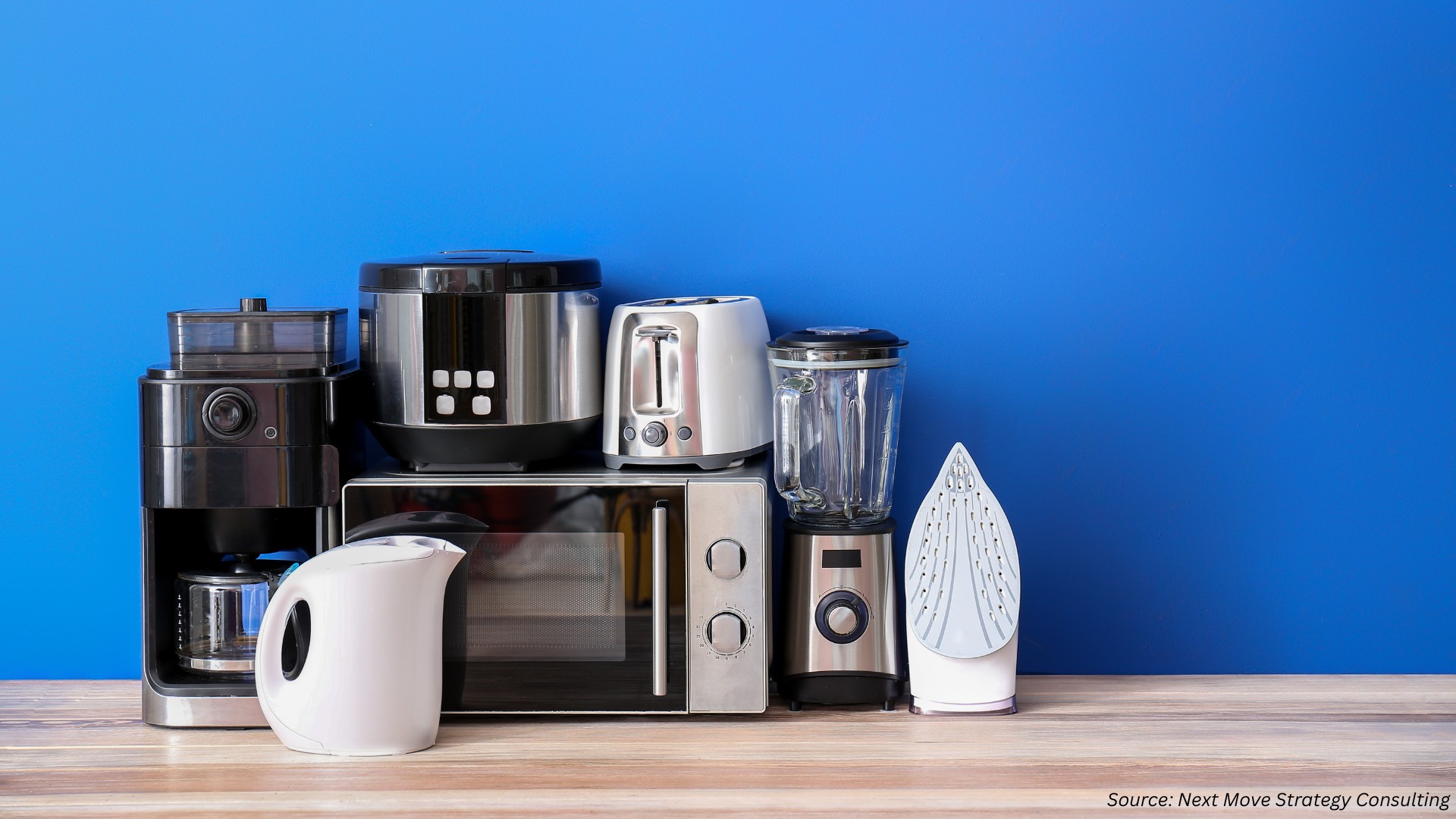Leaders in the Kitchen Appliances Market: Who’s Dominating in 2025?
Published: 2025-09-10

The Kitchen Appliances Market is booming, driven by smart technology, sustainability, and changing consumer lifestyles. In 2030, this global industry is predicted to value at USD 320.01 billion and with a CAGR of 5.9%.
But who’s leading the charge? Let’s dive into the key players, their strategies, and what makes them stand out in this dynamic market.
Top Players in the Kitchen Appliances Market
Several companies dominate the kitchen appliances market through innovation, strategic acquisitions, and strong brand presence. Below, we explore the leaders based on recent company filings, press releases, and verified sources.
1. Whirlpool Corporation
Whirlpool Corporation, the world's leading manufacturer and marketer of home appliances, has introduced many of the country's household firsts - from the countertop microwave to the automatic washing machine. The company is a marketer of major home appliances, with annual sales of more than $19 billion, more than 73,000 employees, and 69 manufacturing and technology research centers around the world. The company markets Whirlpool, Maytag, KitchenAid, Jenn-Air, Amana, Brastemp, Bauknecht and other major brand names to consumers in nearly every country around the world.
In its 2024 annual report, the company reported approximately $17 billion in annual sales - close to 90% of which were in the Americas - 44,000 employees and 40 manufacturing and technology research centers.
Whirlpool actively emphasizes both energy-efficient and smart appliances in their product offerings. They integrate features like load sensing, steam cleaning, and smart technology in laundry appliances. Whirlpool® Smart Appliances can help you take on the day with smart devices you may already be using, including Google Assistant and Alexa-enabled products. If compared to Samsung, both brands excel in delivering quality products, but they cater to different preferences. Below is a table highlighting the main differences:
|
Feature |
Samsung refrigerators |
Whirlpool refrigerators |
|
Cooling technology |
Twin Cooling Plus ensures |
Adaptive Intelligence Technology optimises |
|
Energy efficiency |
Highly energy-efficient with |
Offers high-efficiency models like |
|
Storage solutions |
Spacious interior with easy-slide shelves |
Maximised space with flexible storage |
|
Design |
Sleek, modern design with touch controls |
Classic design, prioritising functionality |
|
Noise levels |
Operates quietly due to |
Low noise, but slightly louder |
|
Price range |
Premium pricing, especially for |
More budget-friendly options |
2. Electrolux Group
With its newly launched kitchen range from premium brand AEG, Electrolux Group is further strengthening its offering in the higher value built-in categories. Responding to growing demand for high-quality, personalized and sustainable solutions, the new range offers enhanced consumer benefits including AI-assisted cooking, energy-saving product features, and award-winning design.
Based upon deep consumer insight, the new AEG kitchen range has solutions in every product category: ovens, hobs, hoods, refrigeration, and dishwashers. Designed for consumers who want to take their cooking skills further, it offers smart technology such as AI TasteAssist, a new cutting-edge function developed to help consumers make the most of their oven when trying new recipes. Research shows that 80% of consumers search online for recipes. By sending the recipe to the oven, the feature analyzes it and automatically selects the optimal cooking settings for the dish, for example by adding steam, which retains flavors and nutrients.
Further, the company focuses on providing energy-efficient products that intuitively help consumers reduce resource consumption. Since the main part of an appliance’s climate footprint happens during its use, this approach is key to the Group’s efforts in combating climate change. On average, the models of new AEG kitchen range can help reduce the carbon footprint by up to 30% with energy-saving features such as a residual heat function for the oven. The Group’s most energy-efficient products typically also have a higher profit margin.
3. Samsung Electronics Co., Ltd.
Samsung is a leader in smart kitchen appliances. For instance, the company held its 2025 Southeast Asia Tech Seminar in Bangkok, Thailand on June 20, unveiling its latest advancements in home appliances for the region:
-
Samsung’s commitment to making home living easier and more intuitive. This commitment is underscored by its “AI Home” vision, which focuses on the four key pillars of Ease, Save, Care, and Secure.
-
One of the centerpieces of this experience is the upgraded AI Home display — a smart screen now available across more appliances, which enables users to seamlessly access functions, view personalised information on their Daily Board, and manage their home using Map View. The screen also connects third-party devices via SmartThings, eliminating the need for a separate hub.
-
To enhance hands-free control experiences, the Bixby voice assistant now includes Voice ID, allowing the system to recognise individual users registered in advance, sync personal calendars and even mirror Galaxy smartphone accessibility settings for better visibility.
-
Another highlight was the introduction of the new Side-by-Side model, which was recently launched for the Southeast Asian market. It features an integrated screen for enhanced usability, supports AI Energy Mode through built-in Wi-Fi connectivity and includes Auto Open Door, which allows users to open the door with just a light touch.
-
Samsung continues to lead in laundry solutions with AI-enhanced functionality that delivers higher levels of convenience and efficiency. In response to regional demands, Samsung is incorporating AI Wash, offering a range of other AI features, including AI Energy Mode and AI VRT+.
-
The ‘Good Sleep’ mode was also introduced, which allows users to connect their air conditioners with their Galaxy Watch series and Galaxy Ring to enable automatic temperature adjustment of the air conditioner to optimal levels from the wearable’s detection of their sleep stage. The newly launched air conditioner lineup was also on display during the seminar, giving attendees the opportunity to discover more about Samsung’s intelligent climate solutions that offer seamless smart experiences with built-in Wi-Fi connectivity.
-
Samsung is also introducing its most advanced vacuum products yet. The Bespoke AI Jet Ultra is Samsung’s most powerful cordless stick vacuum, boasting up to 400W of suction power and AI Cleaning Mode 2.0, which can now detect corner types and floor variations – such as carpets, hard floors, mats – for smarter cleaning.
The company’s hold across both hardware and software offerings is undeniable.
Market Trends Driving Leadership
The kitchen appliances market is shaped by several trends, which leading companies are leveraging to maintain their edge.
-
Smart Appliances: IoT integration, as seen in Samsung’s launches, allows remote control and voice activation, appealing to consumers.
-
Sustainability: Energy-efficient appliances, like those from Electrolux, contribute toward the circular economy by integrating a circular approach into our products and solutions. They assure consumers by claiming to manage chemicals carefully and replace those that cause concern. Their products are to be made in the same way throughout our global supply chain – with respect for the people who made them and care for the environment.
Challenges Facing Market Leaders
Despite their success, leaders face challenges that could impact their dominance.
-
Competition: Intense rivalry among Whirlpool and Samsung requires constant innovation.
-
High Costs: The high cost of advanced kitchen appliances is the major factor restraining the growth of the market.
Leaders must navigate competition, supply chain disruptions, and price sensitivity to maintain their edge.
Next Steps: Actionable Takeaways for Stakeholders
To stay competitive or make informed decisions in the kitchen appliances market, consider these steps:
-
Invest in Smart Technology: Prioritize IoT-enabled appliances to meet consumer demand for connectivity.
-
Focus on Sustainability: Develop energy-efficient products to align with eco-conscious trends.
About the Author
 Sneha Chakraborty is a seasoned SEO Executive and Content Writer with over 4 years of experience in the digital marketing space, bringing a strong command of online visibility strategies and a keen insight into the evolving digital landscape. She specializes in enhancing online visibility and user engagement through data-driven strategies and creative content solutions. She has been closely observing trends across various industry domains, bringing insightful perspectives into her writing. Sneha is passionate about translating complex digital concepts into accessible content for a wide audience. Outside of work, she enjoys reading, sketching, and exploring the outdoors through nature photography.
Sneha Chakraborty is a seasoned SEO Executive and Content Writer with over 4 years of experience in the digital marketing space, bringing a strong command of online visibility strategies and a keen insight into the evolving digital landscape. She specializes in enhancing online visibility and user engagement through data-driven strategies and creative content solutions. She has been closely observing trends across various industry domains, bringing insightful perspectives into her writing. Sneha is passionate about translating complex digital concepts into accessible content for a wide audience. Outside of work, she enjoys reading, sketching, and exploring the outdoors through nature photography.
About the Reviewer
 Sanyukta Deb is a seasoned Content Writer and Team Leader in Digital Marketing, known for her expertise in crafting online visibility strategies and navigating the dynamic digital landscape. With a flair for developing data-driven campaigns and producing compelling, audience-focused content, she helps brands elevate their presence and deepen user engagement. Beyond her professional endeavors, Sanyukta finds inspiration in creative projects and design pursuits.
Sanyukta Deb is a seasoned Content Writer and Team Leader in Digital Marketing, known for her expertise in crafting online visibility strategies and navigating the dynamic digital landscape. With a flair for developing data-driven campaigns and producing compelling, audience-focused content, she helps brands elevate their presence and deepen user engagement. Beyond her professional endeavors, Sanyukta finds inspiration in creative projects and design pursuits.
















Add Comment